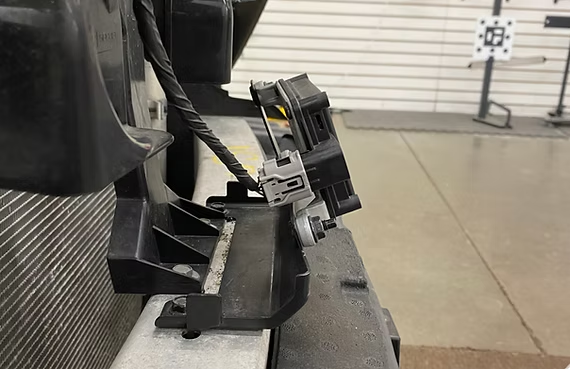Successful ADAS calibrations require a precise mechanical foundation. When a vehicle’s underlying structure isn’t perfectly aligned to factory specifications, calibration procedures may fail or—more dangerously—complete with inaccurate results. Modern advanced driver assistance systems including lane keeping assist, adaptive cruise control, blind spot monitoring, and 360-degree cameras depend on sensors that must maintain exact alignment relative to the vehicle’s physical structure. Mechanical imperfections can disrupt this critical relationship, leading to unsafe system behavior and compromised safety features.
Many ADAS systems rely on inputs from wheel speed sensors, steering angle sensors, and ride height monitors to calculate vehicle trajectories and interpret surroundings. Suspension issues can severely impact calibration accuracy:
When suspension geometry is compromised, vehicle systems may miscalculate sensor angles and distances. This often results in lane assist functions that veer unexpectedly or forward-facing cameras that misinterpret road curvature and obstacle distance.
Steering system integrity directly impacts ADAS calibration success. Front radar and camera systems typically require:
If a vehicle’s alignment is incorrect or the steering angle sensor hasn’t been reset following steering component replacement, the system may operate with false positioning data. This misalignment throws off camera and radar positioning, resulting in unpredictable ADAS behavior.
Even subtle frame or unibody distortion can cause significant sensor misalignment. ADAS sensors depend on precise mounting angles relative to the vehicle’s:
When unibody components are twisted or frame rails are bent—even by millimeters—radar and camera modules may appear correctly mounted while actually pointing in the wrong direction. This subtle misalignment can cause dangerous system errors despite showing successful calibration completion in diagnostic software.
Proper sensor mounting is critical following collision repairs. Installation requirements include:
A misaligned camera mount, bent radar bracket, or improperly secured bumper can shift sensors out of position. These issues are difficult to detect visually but will cause calibration failures or produce incorrect calibration results that compromise safety system performance.
Wheels and tires play a surprisingly significant role in ADAS calibration accuracy:
Many OEMs specify exact tire requirements for valid calibration procedures. Improper tire specifications affect ride height, vehicle leveling, and rolling distance measurements during dynamic calibrations. Even slight variations can tilt sensor angles and distort the system’s road interpretation.
Vehicle weight distribution significantly impacts calibration success. Proper ADAS calibration typically requires:
A vehicle carrying tools, equipment, or operating with low fluid levels can sit at improper ride height, causing sensor angles to shift subtly. This often leads to calibration failures or—more dangerously—successful calibrations with compromised accuracy.
Non-OEM parts can interfere with sensor performance and calibration accuracy:
Some aftermarket components don’t meet OEM specifications for radar wave transmission or camera positioning. While calibration procedures might appear successful, these parts can produce unreliable readings in real-world driving conditions.
At Crown Collision Solutions, we implement a comprehensive inspection process before attempting ADAS calibrations:
We treat ADAS calibration as an integrated precision process combining mechanical integrity and electronic calibration—not simply a software procedure. Every vehicle undergoes thorough mechanical verification before calibration begins, ensuring systems are calibrated on a properly prepared foundation.
ADAS sensors can only perform as accurately as the mechanical platform they’re mounted to. Without proper alignment, mounting, and structural integrity, even the most advanced sensors cannot provide reliable data. This is why Crown Collision Solutions employs a mechanical-first approach to every calibration job, ensuring each vehicle’s physical integrity before recalibrating its advanced safety systems.
Our commitment to addressing underlying mechanical issues before performing ADAS calibrations results in consistently accurate system performance, ensuring your vehicle’s safety systems function exactly as designed by the manufacturer.
Contact Crown Collision Solutions today to schedule a comprehensive ADAS system evaluation that includes full mechanical inspection and factory-specified calibration.
